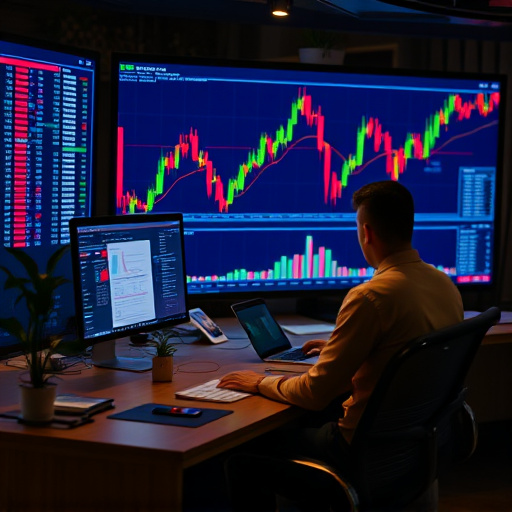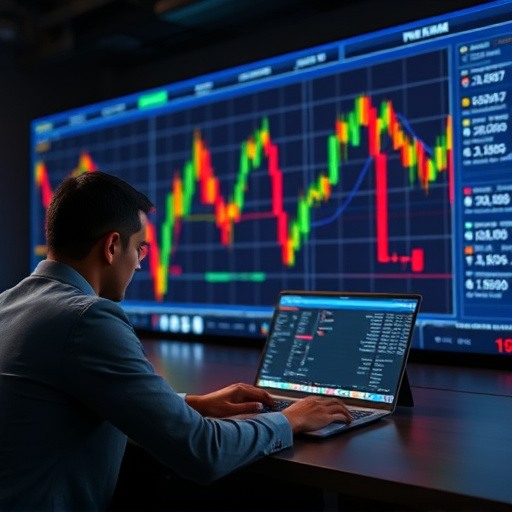Mastering Forex Trading: Australian Strategies for Success
Forex trading, operating globally 24/7 across diverse time zones, requires understanding currency pairs, exchange rates, and pips, along with technical and fundamental analysis. Australian traders leverage high liquidity, tight spreads, and 24-h…….

Forex trading, operating globally 24/7 across diverse time zones, requires understanding currency pairs, exchange rates, and pips, along with technical and fundamental analysis. Australian traders leverage high liquidity, tight spreads, and 24-hour operation to capitalize on consistent opportunities. Technical analysis tools like moving averages, RSI, and Fibonacci retracements, combined with economic data releases, enable informed trading decisions. Effective risk management through stop-loss orders and strategic position sizing safeguards capital and enhances profitability. Backtesting and live trading integrate theoretical knowledge with real-world conditions for confident decision-making in the dynamic forex market.
Looking to master the art of forex trading in Australia? This comprehensive guide is your starting point. We break down complex concepts into simple, actionable steps for beginners. From understanding the fundamentals of forex markets to advanced techniques like technical analysis and risk management, we equip you with the tools to succeed. Learn proven strategies tailored to the Australian market, explore essential indicators, and gain practical skills through backtesting and live trading. Elevate your forex trading journey today!
- Understanding Forex Trading: A Beginner's Guide
- Unlocking Profitable Strategies in the Australian Market
- Technical Analysis: Tools and Indicators for Informed Decisions
- Risk Management Techniques for Forex Traders
- Practical Application: Backtesting and Live Trading Techniques
Understanding Forex Trading: A Beginner's Guide

Forex trading, short for foreign exchange trading, is a complex yet fascinating market that allows investors to buy and sell currencies from around the globe. It’s a 24/5 market, operating across different time zones, which makes it an exciting yet demanding space for beginners to navigate. Understanding forex trading involves grasping key concepts like currency pairs (the quote of two different currencies), exchange rates (how much one currency is worth in relation to another), and pips (the smallest unit of price movement).
There are various forex trading strategies that traders use, including technical analysis, which relies on historical data and charts to predict future trends, and fundamental analysis, which considers economic factors like interest rates, inflation, and geopolitical events. For newcomers, it’s crucial to educate themselves on these strategies, learn risk management techniques, and start small, observing the market and making low-risk trades before committing larger capital.
Unlocking Profitable Strategies in the Australian Market

In Australia, the foreign exchange market offers a dynamic and potentially lucrative arena for traders seeking to implement effective forex trading strategies. Unlocking successful approaches requires a deep understanding of the unique characteristics of this specific market, including its high liquidity, tight spreads, and 24-hour operation. By leveraging these advantages, traders can capitalize on consistent opportunities.
One key strategy involves embracing technical analysis tools to identify trends and patterns in currency price movements. Moving averages, relative strength indexes (RSI), and Fibonacci retracements are powerful indicators that can guide traders in making informed decisions. Additionally, staying abreast of economic calendars is essential, as Australia’s economic data releases, such as employment reports and interest rate decisions by the Reserve Bank, significantly influence market dynamics. Incorporating these strategies into a well-researched trading plan can lead to increased profitability within the Australian forex market.
Technical Analysis: Tools and Indicators for Informed Decisions

Technical analysis is a crucial component of successful forex trading, providing traders with valuable insights into market trends and potential price movements. It involves the use of various tools and indicators to interpret chart patterns, identify key levels, and make informed decisions. Forex traders in Australia employ a range of technical analysis techniques, including moving averages, Relative Strength Index (RSI), Bollinger Bands, and Fibonacci retracements, among others.
These tools help traders identify support and resistance levels, trends, momentum, and potential reversals. For instance, moving averages smooth out price data, revealing the overall trend, while RSI measures overbought or oversold conditions. Bollinger Bands indicate volatility by showing the range of price fluctuations, enabling traders to anticipate potential breakouts or consolidations. By combining these technical analysis tools, Australian forex traders gain a comprehensive understanding of market dynamics, enhancing their ability to execute effective trading strategies and make well-informed decisions in the dynamic forex market.
Risk Management Techniques for Forex Traders

In the dynamic world of forex trading, risk management is a cornerstone of successful strategies. Australian traders should embrace essential techniques to safeguard their capital and enhance profitability. One key approach involves setting defined stop-loss orders, allowing traders to limit potential losses by automatically closing positions once a predetermined price level is reached. This method ensures discipline and prevents emotional decisions in volatile markets.
Additionally, position sizing plays a pivotal role in risk management. Traders should aim to allocate only a small percentage of their total capital to each trade, diversifying across multiple currency pairs. By managing risk effectively through stop-loss orders and strategic position sizing, forex traders in Australia can navigate market uncertainties with confidence, ultimately refining their overall trading performance and increasing the likelihood of consistent gains.
Practical Application: Backtesting and Live Trading Techniques

Practical application is key in forex trading, and two powerful techniques that traders in Australia can leverage are backtesting and live trading. Backtesting involves using historical market data to simulate trades based on a specific strategy. This process allows traders to evaluate the potential profitability and effectiveness of their strategies before risking real capital. By running numerous scenarios, traders gain insights into the strengths and weaknesses of their approaches, enabling them to refine and optimize their forex trading strategies accordingly.
Live trading, on the other hand, is where theoretical knowledge meets real-world market conditions. Traders execute trades using their developed strategies, closely monitoring price movements and adjusting as necessary. This dynamic environment provides an opportunity to test the resilience of their strategies under varying market conditions. Combining backtesting and live trading offers a comprehensive approach, ensuring traders in Australia are well-prepared to navigate the complexities of the forex market with confidence and informed decision-making.
For aspiring Australian forex traders, mastering these comprehensive lessons is a pivotal step towards navigating the dynamic global market. By understanding fundamental concepts, leveraging profitable strategies, and adopting robust risk management techniques, traders can confidently execute trades using technical analysis tools. Practical application through backtesting and live trading ensures a well-rounded education, empowering individuals to excel in forex trading strategies and achieve their financial goals.







